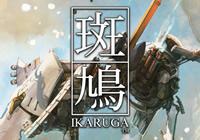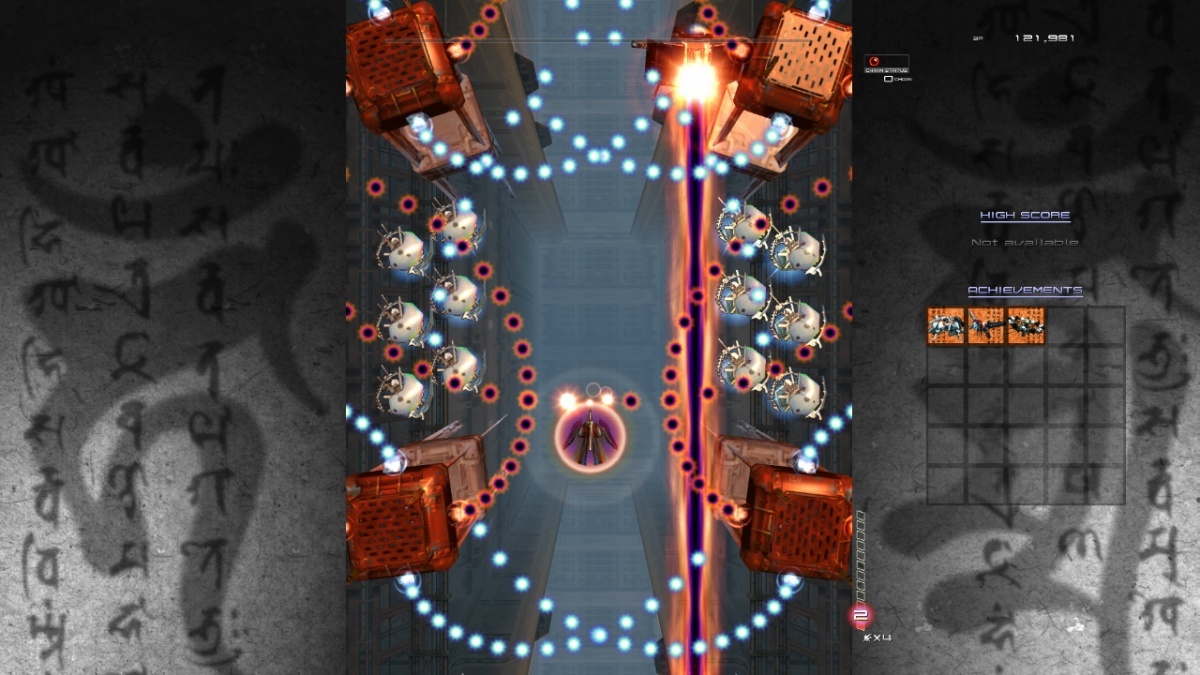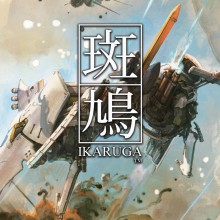Ikaruga (Nintendo Switch) Review
By Rudy Lavaux  07.06.2018
07.06.2018

Frequently, gamers witness the comeback of great classics from the past that have become so overpriced on original hardware over the years that they both fascinate and disgust people because they tend to become so hard to get a hold of at a good price. Ikaruga is one such title, although it does not reach the heights of its predecessor, Radiant Silvergun for the SEGA Saturn. Still, for anyone willing to acquire a physical copy today, they have to be ready to pay a pretty penny for it. Thankfully, digital HD re-releases, or in some cases on Nintendo's side of things, Virtual Console releases, make such titles available at a much more affordable price for newer audiences to sample on newer hardware. Ikaruga has seen re-releases over the years since all the way back on the Xbox 360 but also in more recent years on Steam. While the Switch may not yet offer a physical release of Ikaruga (this may well change in the not so distant future with any luck), it still offers one of the most famous shmups in the world, for the first time in a fully hybrid home and handheld version!
The basic concept of Ikaruga is very simple and should be known to most people by now… but for the uninitiated, here is a recap. The player takes control of a space battle craft that shoots an infinite amount of bullets at incoming targets and has to avoid being hit by overwhelming amounts of bullets displayed on the screen. The action is limited to a 2D plane, despite the game using 3D graphics to display the action, so the player has to manage to carefully manoeuvre the ship through the usually clearly defined patterns of bullets on-screen, while still managing to take down incoming foes. This is pretty much the definition of what a danmaku or "bullet-hell" or more literally "bullet-curtain" shooter game is expected to play like. Ikaruga, though, as most players will know, brings in a distinct mechanic to differentiate itself drastically from the competition of the time but even in this day and age: its polarity system. Borrowed from one of Treasure's previous titles for the Saturn, Silhouette Mirage, the polarity system lets the player change the polarity of their ship, from black to white or vice versa, to make it immune to one polarity of bullets but lethally vulnerable to the other, while also making the player's own bullets take on those same properties that act in the same way against incoming foes that also bear one polarity or the other but are, in 99% of cases anyway, incapable of shifting polarity themselves. In practice, this means, for example, that if the ship is white, it will absorb white bullets and shoot bullets of the same colour, but will die in one hit from an incoming black bullet.
This distinctive property sets Ikaruga aside from most games of the same genre, even for die-hard fans thereof, because it must be approached in a different way as a result of that system, making it a game that most people know and revere, but which often turns out to not be the favourite of those same players, because not only does the player have to watch out for those well defined patterns of bullets, but also keep track of the different colours of everything. Additionally, absorbing bullets fills in a special gauge that lets the player unleash powerful homing lasers on the enemy, the amount of which depends on how full the gauge is. Last but not least, no bullet hell shooter would be complete without a combo system that can be exploited to reach ridiculously high scores for bragging rights. Ikaruga relies on a chain system where the player must also, in addition to all the rest, pay attention to kill enemies by groups of three of the same colour.

Three whites in a row, for example, before killing three other whites or switching to blacks at the risk of losing a chain. The higher the chain level, the more points are awarded for each completed chain and a bonus score is awarded at the end of each stage for achieving a high max chain count. This whole concept is, in essence, what makes Ikaruga tick as an engrossing and gripping interactive experience just by how it plays and not because of the story it tells. Indeed, the background story of Ikaruga is, by shmup standards, rather convoluted, but it is still all things considered fairly thin, but that's not the point of the genre anyway. Shinra, the main character, crash landed in Shinkai village while fighting a war against a powerful enemy and it so happens that the village has been holding onto a powerful vessel called Ikaruga (or Ginkei if playing with the second player ship) with the power, in the hands of the skilled pilot that the player is expected to be, to take down the hordes of enemies that threaten the Tenkaku freedom federation. Naturally, none of this is even touched upon within the game itself and in the absence of a physical package with manual, at time of writing, none of this is explained to the player but, again, this is not a deterrent from the shmup experience at all and it comes with the territory. The above snippet of story background is actually taken from the GameCube manual for information. Speaking of which, later HD versions included some poem-like bits of story interspersed at the start of every chapter. Those are, expectedly, found in this Switch version, as well. This Switch version really packs pretty much everything that could be found in previous versions and then some as a matter of fact, being mostly a copy-paste of the Steam iteration.
For those that haven't played any of the more recent versions, however, let it be known that most of the elements that were originally unlockable in the GameCube version are now unlocked from the start. That includes art galleries, sound test, prototype play mode, and free play mode. This would take away from what was originally a grinding romp to unlock everything that was to be unlocked but there is now an achievement system built into the game itself that still sets challenges for the player to complete. Therefore, there are still plenty of objectives for the persevering player to fulfil should they wish to, beyond simply sitting through the whole game.

That is most fortunate because Ikaruga has inherited from its arcade roots a very short length, clocking in at just five stages, with a regular playthrough typically lasting 40 minutes at the most. Therefore, replayability is obviously an essential element to render the experience big enough to make it worth investing money into. The achievement system is one such enticing feature and so is the online leaderboard system. Beyond just seeing another player's name up on the leaderboards, the system uploads an entire playthrough onto a server from which other leading players' playthroughs can be downloaded onto the Nintendo Switch and examined closely to learn from the best. It is a great addition, with the only minor drawback being that preparation of the replay, as uploading and syncing with the server is a rather lengthy process at the end of each playthrough. As can be expected from a game with tweakable options such as stock, continues, and scores to achieve for extra lives... being able to upload a score and replay requires that the player has the game set to default settings, which is three lives and no continues. A daunting prospect even for the seasoned shmup gamer as this is certainly not an easy title to sit through but it is a fair proposal that online leaderboard score abide to the default arcade settings and, besides, nothing prevents people from still changing those settings and just playing for fun or for training through repeated playthroughs until they feel confident enough to tackle the default arcade mode.
Mentioned previously is also the prototype play mode, which sets the game to follow the rules it was supposed to follow before its initial release, in accordance with its creator's initial vision. In that mode, homing lasers don't exist but absorbing enemy bullets is required to even be allowed to shoot anything. That's right, in prototype mode, the player, in addition to all of the aforementioned difficulties to overcome, also has to make do with a limited supply of ammo that can only be replenished by absorbing enemy bullets! Naturally this mode will only be appealing to a fraction of even this game's fan-base due to its insane difficulty, but no doubt there are seasoned, pro Ikaruga players out there who shall drool at the prospect of an even more challenging version of their favourite title, although those probably already have seen it all by now but, still, let it be known that the Switch obviously did not ditch this mode. One thing, however, that stands out in this new version as opposed to the initial early 2000s versions, including the GameCube version, which at the time was the only release outside of Japan for consoles: true analogue controls at last.

On GameCube, though, the control stick would give full 360-degree control of the ship; there was no sensitivity detection for more subtle, gentle movement to be able to follow the movement of enemy patterns and stay out of danger. The Switch version at least does away with that limitation and finally offers an experience that feels much better to control and less unfair. That's not saying much obviously, because Ikaruga is still one heck of a hard game to play through but, nevertheless, it's a little difference that changes more things than it may appear at first for those who haven't played it at all outside of the realm of disc-based consoles in the early 2000s. Of course, the Joy-Con's tiny sticks may make it slightly harder to gracefully slowly move away from an incoming enemy bullet curtain or laser but those do the trick just fine and it is worth mentioning that this Switch version finally offers what no other version before has: portable two-player mode! Sure, mobile devices, based on Android and iOS, offered Ikaruga on the go several years back already, but being limited to touch screen controls isn't really what any shmup fan wants out of their games, so, already, Ikaruga on Switch offers a much better experience on the go but, in addition to this, the Switch's dual Joy-Con setup is perfect for two players to come together and play Ikaruga wherever and whenever, which does make this version stand tall and proud amongst the rest where it otherwise would perhaps have only just matched them.
Indeed, it otherwise looks and plays exactly like the Steam version, locking at 1080p60 in docked mode and 720p60 in handheld mode while offering TATE mode in both configurations for players who want their vertical shmup experience to fill a whole, vertically-oriented screen. No performance dips are to be reported outside of some minor frame-rate drops happening on huge boss explosions at the end of each stage. This, for the record, already happened on the GameCube, but it was way worse then. Now, the game has moved to HD realm and on Switch those slowdowns in those very specific moments still occur, but not quite as badly as before. This is still due, no doubt, to the huge outburst of alpha transparencies being thrown at the GPU for those few seconds, which make the Switch's limited memory bandwidth choke a little, but overall the game keeps and retains its look from back in the day, just with an HD lick of paint to make things look one heck of a lot smoother than any other previous version, save obviously for the Steam version over on PC.

Cubed3 Rating
Exceptional - Gold Award

Small performance hiccups on boss explosions aside, which were already present in an even worse state back on the GameCube, this is the new definitive edition of the great classic on Nintendo Switch. Not only is it enjoyable and fully featured both at 1080p60 in docked mode and 720p60 in handheld mode, but it is obviously way more enjoyable on the go than the version available for smart devices due to real built-in controls but also, for the first time, portable two-player mode on the same device with split Joy-Con, which happens to work really well. It is still as challenging a romp as it ever was, but for anyone remotely interested by the genre, it will prove indispensable.
Comments
Comments are currently disabled

 Sign In
Sign In Game Details
Game Details
 Out now
Out now  Out now
Out now  Out now
Out now  Out now
Out now  Subscribe to this topic
Subscribe to this topic Features
Features





 Top
Top

